Paper Doll
NAPO2018: Advancing at a Retreat

As I write this post, I’m counting down the hours until I head to suburban Chicago for NAPO 2018. From 2002 through 2017, I had the pleasure of attending my industry’s NAPO Conference and Expo each year. 2018, however, has brought quite a few new developments.
First, we’ve changed our name! We’re still NAPO, but our full name has changed from the National Association of Professional Organizers to the National Association of Productivity and Organizing Professionals. While personal and professional productivity (say that three times quickly!) has always been a huge part of the organizing process, it’s taken many decades to give that side of what we do the name-value attention it deserves.
Second, we’re learning not to hide our light under a bushel (because piling things atop other things just leads to clutter). Instead, we’ve been spreading the word about organizing far and wide. For example, you may have seen our current president (and my NAPO 2015 conference roommate) Ellen Rubin Delap and some of our colleagues on CBS Sunday Morning this past weekend, talking about why people are so greatly in need of organizing assistance and what we can do to help.
I’ve been trying to spread the word, too, such as with my guest post for the NAPO Get Organized blog, entitled In Checkbooks and Underwear Drawers: What Certified Professional Organizers Offer Our Clients. The goal was to make sure that everyone (the public, the media, aspiring professional organizers, veterans, etc.) understands why we professional organizers (including CPOs, like me) do what we do: for you, the client. We recognize the vulnerability you share when inviting us into your homes and offices, and we want to honor you with respect.
Third, at least for this year, our conference structure is changing. There’s no expo. That means that Paper Doll won’t be frantically running around the expo floor in order to learn about every new product on display. (Never worry, readers. This just means that I’ll be spending more time independently investigating the great organizing products on the horizon. If your company makes something novel in support of organizing or productivity, be sure to use the contact page to let me know about it!)
I should note while there is no formal expo, two of our beloved NAPO business partners will be in attendance as conference sponsors. So, I’m looking forward to seeing our friends at Smead, the source of so many past post-conference product reviews, and Brother, from whom I just bought my new laser printer for Paper Doll HQ, and from whom I’m hoping to learn more about the Cube, their Bluetooth-connected label printer.
Fourth, and finally, this year’s conference is envisioned as a retreat, with more focus on self-care, not just so that we professional organizers can balance our lives, but so that we can better help our clients achieve balance.
Sure, we’ve got our traditional educational workshops on ADHD, space planning, chronic disorganization, Quickbooks efficiency, and the myths surrounding multitasking. But this year’s conference has a real focus on the robust emotional side of what we do and what our clients need, with topics ranging from silencing self-doubt and creating better boundaries, to improving self-care (with a focus on better sleep), to Buddhist principles and “Yogic tools” for organizers needs. Gracious!
A retreat brings to mind a spa-like experience, and in addition to our classroom experiences, we’ll have opportunities to participate in yoga, learn belly dancing, and embrace mindfulness. I also always like the duality of the term “retreat” — it’s about taking a step back from the busy hum of everyday life, but it’s also a possibility to advance — advance my knowledge, my skills, and my ability to help readers and clients.
It doesn’t hurt that the conference/retreat is being held at the Q Center in St. Charles, Illinois. Not too shabby, eh?

I look forward to reporting to you on this year’s conference retreat. Until then, feel free to type “NAPO” or “expo” in the search box on the left side of my site to revel in the products and experiences of past NAPO conferences.
Paper Doll on The Truth(s) About Standing Desks
Are you sitting down?
That’s what we ask people when we’re about to share upsetting news. Well, if you’re sitting down, and if you tend to be sitting down much of the time, this may not be news if you’ve been paying attention the past few years, but it’s certainly upsetting.
Spending too much time at our desks, plopped down (and probably hunched over), is pretty bad for us for a number of reasons, including those illustrated in this adorable TED-Ed Talk:
Articles like Sit Less, Live Longer and Too Much Sitting May Thin the Part of Your Brain That’s Important for Memory point out the major physical and cognitive problems associated with remaining seated.
But this doesn’t get into the latest and perhaps most important research. According to science writer Gretchen Reynolds, a recent Swedish study published in the British Journal of Sports Medicine suggests that when you sit all day, your telomeres (the tiny caps on the ends of DNA strands) get shorter. Apparently, this is NOT A GOOD THING! As telomeres get shorter, the rate at which the body ages and decays speeds up. Conversely, the study found “that the telomeres in [those] who were sitting the least had lengthened. Their cells seemed to be growing physiologically younger.” Obviously, we all want young cells!
The Push for Standing Desks
So, the experts have said, STAND UP! Why? Well, they figured that for each thing that sitting does to you that’s bad, standing can reverse it.
Let’s start with ergonomics and posture. You can still slump a little when standing, but not to the same extent as when you’re sitting in a chair. So, standing can help you strengthen your core, tighten up your glutes, and strengthen other muscles. There’s also such a thing as Upper and Lower Cross Syndromes, which, when you spend too much time sitting, can lead to tension headaches, shoulder strain, and that oogy feeling of becoming one with your office chair. When you stretch your leg and torso muscles by standing, you’re a bit more fit. Or so the theory goes.
Then there’s your cardiovascular system. Standing while working increases metabolism (vs. sitting down), and the theory is that just by standing, you can reduce your risk of heart disease by increasing your blood circulation. Well, maybe.
The physical advantages of standing vs. sitting make sense. But some researchers have posited that standing has other advantages related to productivity, creativity, and cognition.
With regard to productivity, studies note that while standing, more nutrient-rich blood, more mood-enhancing hormones, and more oxygen can get to the brain. More nutrient-rich blood and oxygen means more cognition, per The Economist, and unless you’re that Danish prince, Hamlet, more thinking means more productivity. (Hamlet, however, really needed a Disney vacation, or at least a mindless afternoon Kardashian-TV.) And more mood-enhancing hormones should, logically (and up to a point), yield more creativity. Whoohoo!
Finally, while a celebrity endorsement doesn’t necessarily imply wisdom, there have certainly been some famous desk-standers, including Ernest Hemingway (who famously said, “Write drunk, edit sober,” so you have to imagine him leaning more than standing), Vladimir Nabakov, Thomas Jefferson, Charles Dickens, Virginia Woolf, and Benjamin Franklin. Good company to keep – though, come to think of it, a number of them were tipplers and likely leaning like Hemingway.
The Tide May Be Turning
Up until recently, everyone had gotten a bit rah-rah about standing desks. There’s money to be made from standing desks, and health and productivity to be gained from standing, per se, so why not try it? Well, standing is well and good, but there’s some doubt as to whether standing desks do that much for you.
Boston Public Radio rather dramatically declared Throw Away Your Standing Desk after interviewing Arthur Caplan, Director of the Division of Medical Ethics at NYU Langone Medical Center about the minimal benefits of just standing while working. (Enjoy the audio for some jokey byplay.)
Further, there’s some shocking reportage that standing desks could be making you dumber! Apparently, a recent study in the journal Ergonomics found that while “due to concerns about excessive sedentary exposure for office workers, alternate work positions,” were studied, but they found that prolonged standing may have negative “health and productivity impacts” and that while creative problem-solving did improve, “reaction time and mental state deteriorated.” Yikes.
So, the answer is, STAND UP, but don’t expect that standing desks are going to yield that many benefits.
The Best of Both Worlds
Use a standing desk if you want (but keep an eye out for muscle fatigue, swelling in your legs, ankles, or feet, and decreased in cognitive function). If your back needs more support, sit at your desk, but set a timer or use an app to remind you to get up from your desk every 45 minutes or so.
Take a brisk walk around the office, do some wall push-ups, or go outside to make a client call and enjoy some fresh air. It’s said that Aristotle’s followers, the Peripatetics, engaged in all of their philosophical discussions while ambling about the Lyceum in ancient Athens. Why not take a page out of their books (scrolls?) and propose West Wing-style walking-and-talking meetings with your colleagues instead of traditional sitting or recently-in-vogue stand-up meetings?
Chances are that movement, rather than just standing, will have a more positive effect, and a change of environment will jump-start your creativity.
Shopping for Your Solution
If you decide you must have a standing desk, Paper Doll has you covered. Really smart consumer sites like Wirecutter like the Fully line of adjustable standing desks, particularly the highly-rated Fully Jarvis Bamboo adjustable standing desk.

Of course, as with all furniture, prices range from high-end adjustable desks like those of Bush Business Furniture’s Stand 80 series to the DIY standing desk options and ideas on Pinterest.
Perhaps you’ve already got a desk you love. You could try what Paper Doll thinks of as a desk-topper (like a mattress pillow-topper), like HumbleWorks. The spine of the HumbleWorks has multiple slots, making it entirely adjustable. No matter your height, you can put your monitor and keyboard shelves at the correct ergonomic position for appropriate eye level and height.
The “spine” piece folds flat when not in use, so it’s easy to store.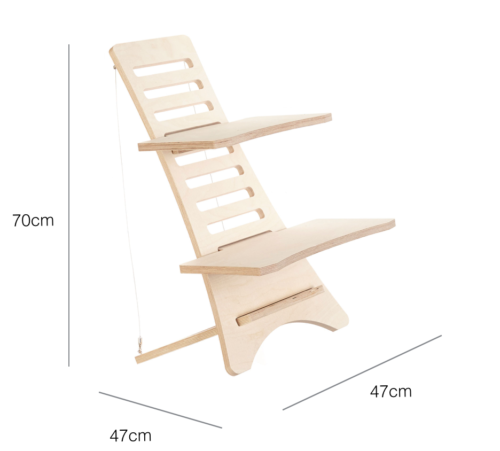
Compare different versions of the HumbleWorks standing desk. For example:
- Stan 1 is compatible with Macs and PC laptops with screens up to 15″, is made of 18mm birch plywood, and is reinforced with steel suspension cables and pins.
- Stan 1.5 is compatible with Macs and PC laptops and desktops with screens up to 17″, is made of 18mm birch plywood, and is reinforced with steel suspension cables and pins.
- Stan 2 is compatible with Macs and PC laptops and desktops with screens up to 27″, is made of 22mm birch plywood, and requires reinforcement.
If you like the wood look but want an alternative that’s more portable (and more price-sensitive) investigate the StandStand, which weighs less than many laptops and can be assembled in minutes. Versions come in bamboo or birch with varying finishes, and in multiple styles (for laptop, laptop-and-mouse, or for two monitors).
Not sure how you feel about the whole standing desk kerfuffle? Not ready to plunk down money for something that may not have a profound impact? Why not start small?
Recently, friend-of-the-blog and Professional Daily Money Manager Nanette Duffey shared her experience with the Ergodriven Spark, a sturdy cardboard standing desk that will only run you $25! It’s not gorgeous, but it gives you plenty of room for your laptop, an external keyboard and mouse, and even a knick-knack or two.
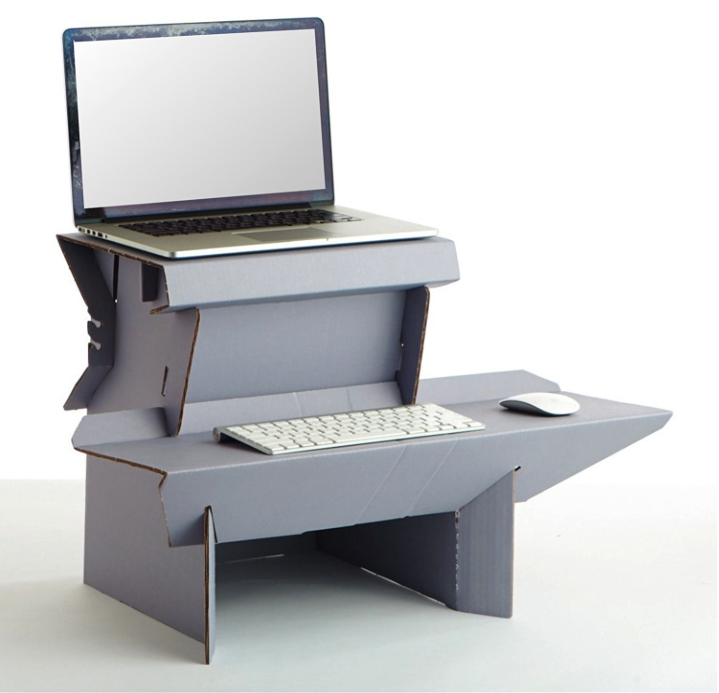
What if you want the best of all worlds? Do you want something fairly portable and full-size? Then your best bet is Refold, a sturdy, stand-up desk made out of thick cardboard! At 14 pounds, it’s not as lightweight as the Ergodriven, but it’s a free-standing desk and will hold 187 pounds! The Refolds come in three sizes: small for petite types (5’2″ and under), medium for those from 5’2″ to 6′, and large for those tall drinks of water over 6 feet.
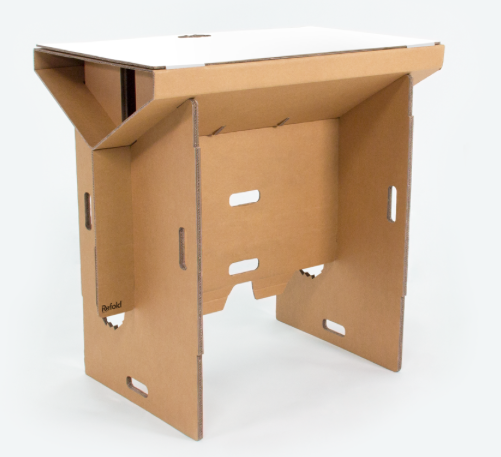
The Refold can have a cardboard or (for a teeny bit more money) a waterproof surface, can be painted or drawn on to customize it, and is fully recyclable. You can also purchase optional legs to turn it into a sitting desk for those days when you just can’t stand it!
One fairly significant note: the Refold is made in New Zealand, meaning that in addition to the $120-$190ish US dollars (depending on your product choice and the exchange rate), you’ll be paying some serious shipping charges.
Safety First
If you decide to keep on sitting, sit safely. Review these essential ergonomic tips for sitting, including:
- Sit with your feet flat on the floor.
- Keep your monitor at the same height as your line of vision.
- Sit so that your elbows are at a 90-degree bend when your hands are on the keyboard.
Finally, whether you decide to sit, stand, or work using a combination of both, make time to check that everything measures appropriately for your height. The NotSitting.com website has created an interactive sitting/standing-height desk calculator so that if you input your height, you can see the appropriate heights (whether sitting or standing) for your eyes and your elbows, and know how far your seat should be from the ground and how far your eyes should be from your monitor. For example, the following graphic shows what Paper Doll‘s ideal sitting and standing situation should be.
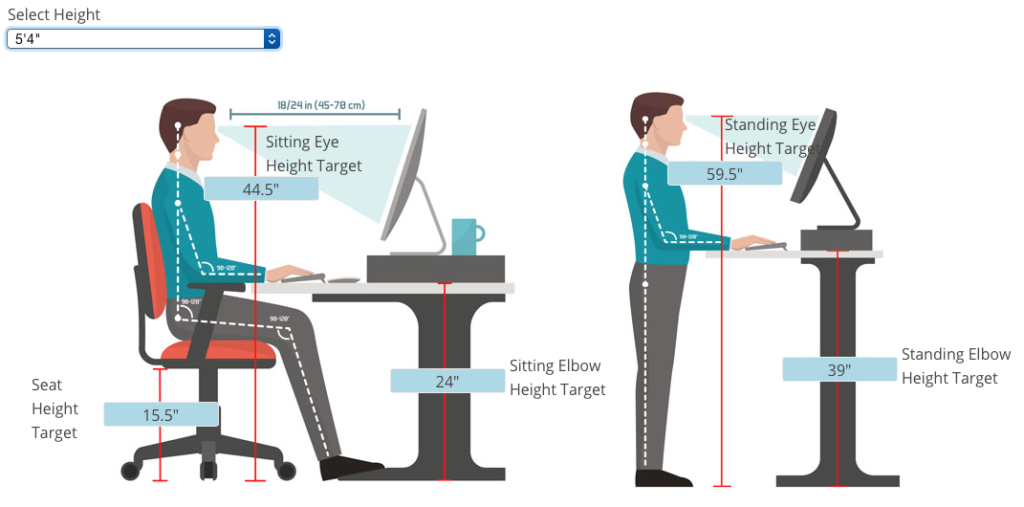
You’ve been reading this post for a while. Why not stand up, stretch, and take a walk to think about what you’ve learned?
Sticky to the Extreme: Organizing Information in Extreme Situations with Post-it® Extreme Notes
Unless you’ve been acting out a real-life Rip Van Winkle scenario for the past four decades, you don’t need anyone to tell you what a Post-it® Note is. In fact, you’re probably already imagining the 3-inch squares with adhesive backing in the traditional bright yellow. Of course, these office supply staples come in gorgeous color varieties and themed color collections with exotic place names – my personal favorite is Marseille, though Bali and Helsinki are soothing, and Miami is so…but I digress.
You can find these original sticky note essentials in sizes ranging from teeny 1 7/8-inch squares to 18 inches by 12 inches (and even as full-sized easel pads), with standard paper or recycled, in regular blocks or tissue-style pop-ups, lined and unlined, square, rectangular, or amusingly shaped. Post-it® even shakes up the adhesive styles – you can get them with regular adhesive, Super-Sticky®, and Full-Stick notes with the whole reverse side able to attach wherever and to whatever.
But never one to rest on its laurels, parent company 3M has decided to take things to extremes.
Post-it® Extreme Notes
You’ve used your favorite stickies for everything from writing down phone numbers to writing To Do lists, from “labeling” paper piles and folders to mapping seating arrangements for weddings. The absolute basic Post-it® Note can handle almost everything you throw at it. But it’s that “almost” that Post-it® has taken as a challenge. I can almost hear the engineers and marketing guys in a room together to ponder what might be possible.
“What if we soaked them?”
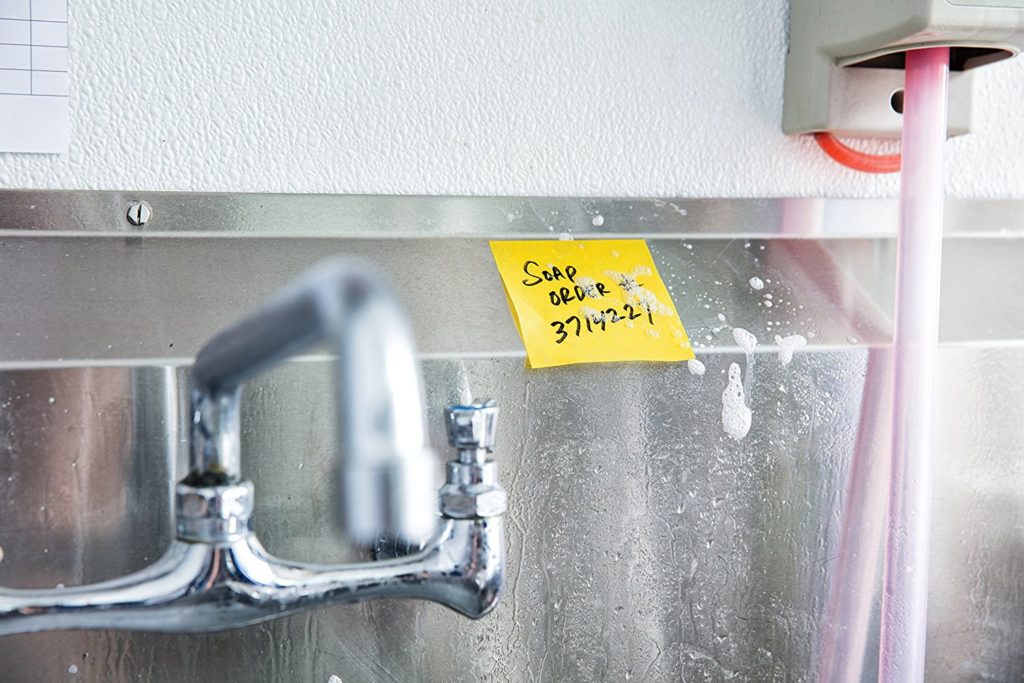
[Maybe they should have studied Paper Doll Writes Between the Raindrops: Waterproof Notebooks for research ideas?]
“What if we froze them?
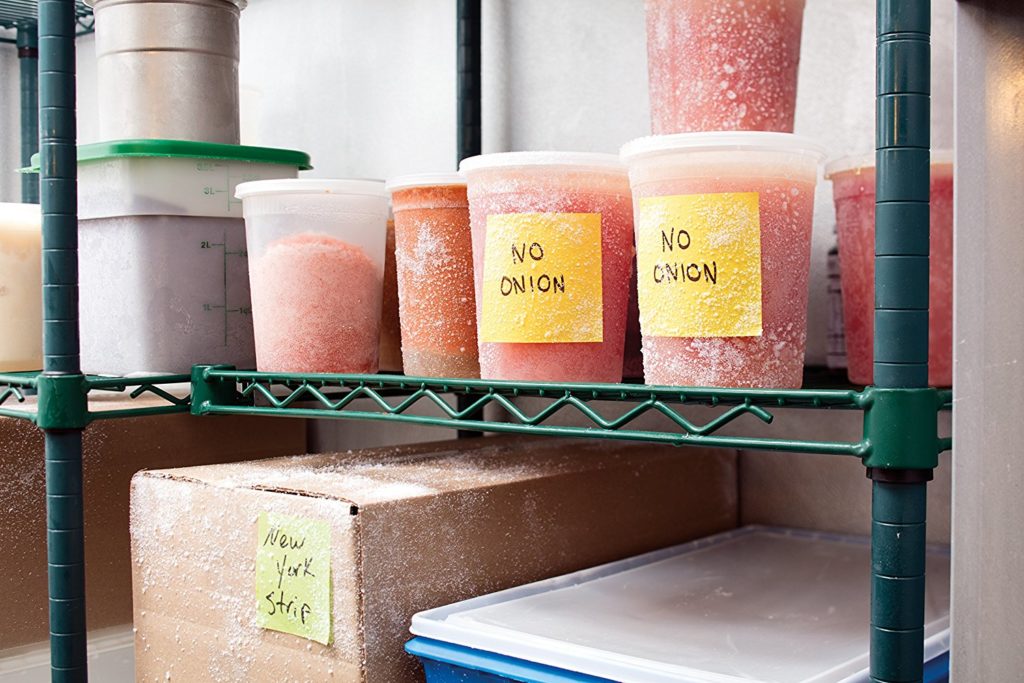
“What if we tried to stick them to bumpy walls? Heck, what if we tried to stick them to brick?!”
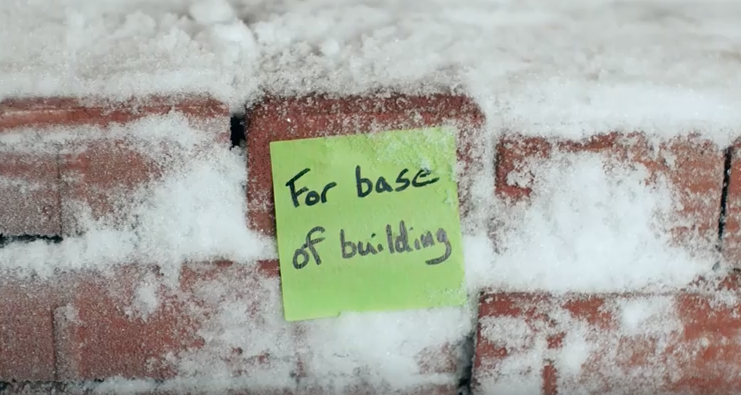
I’m surprised nobody suggested deep-frying them!
Nonetheless, they’ve taken up the gauntlet and produced the sticky notes for the tough gal-and-guy crowd that lives to the extremes.
Post-it® Extreme Notes are made with ultra-strong Dura-Hold™ Paper and Adhesive, giving them some very interesting properties. They’re “writable,” in the company’s words, meaning the special paper doesn’t interfere with the basic purpose – communicating (to yourself or others) – while making what we sometimes consider a white collar product to be pickup-truck tough.
The Extreme Notes:
- Are durable
- Are water-resistant
- Stick to textured surfaces (like brick, rusty metal, uneven wood, construction materials, etc.)
- Stick in both hot and cold environments (meaning they stand up to steam and ice)
- Can be used both inside and outside (from restaurant freezers and steamy kitchens to cars and walls in windy, rainy, gloppy weather)
- Are designed for tough conditions
- Remove cleanly, leaving no residue – just like the traditional notes
See them in action:
The Post-it® Extreme Notes are (at least for now) available only in the traditional 3″ x 3″ size, 45 sheets per pad.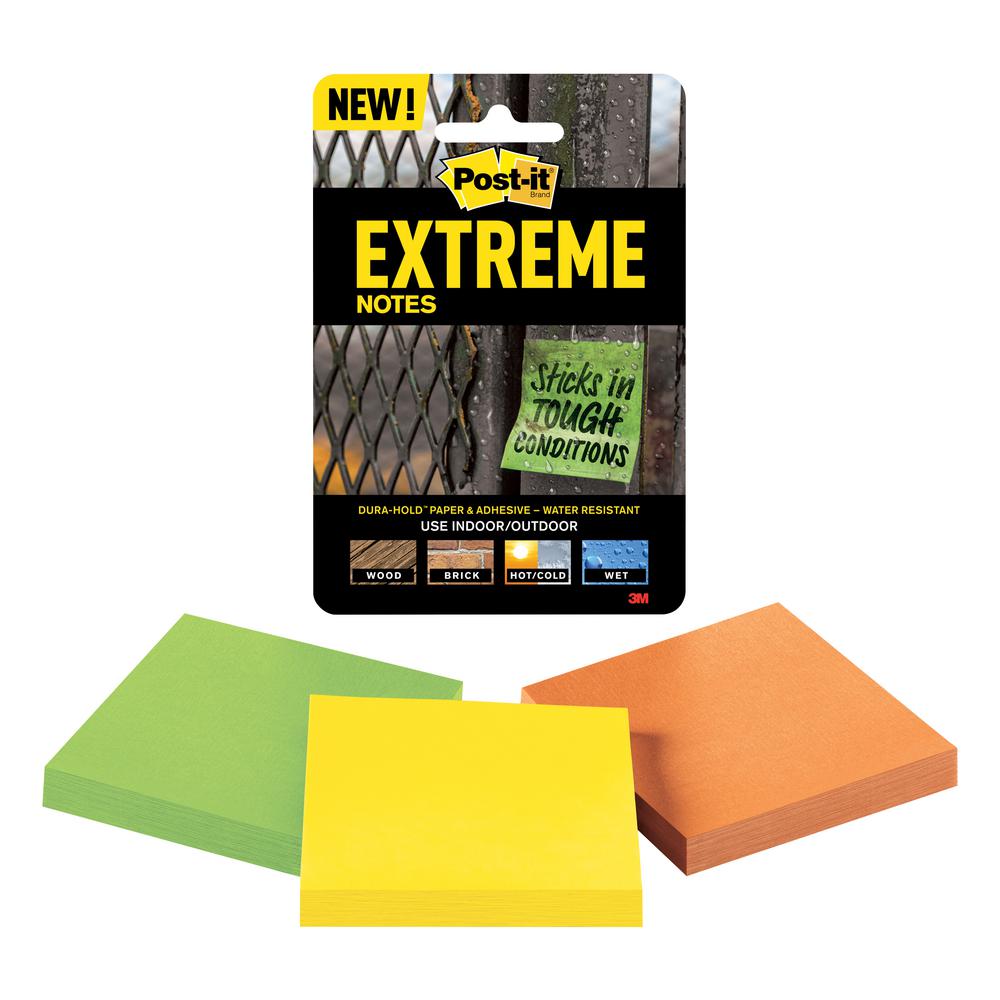 Although they’re made in four colors: orange, green, yellow, and mint, the 3-pad pack (about $5/pack) and 32-pad box varieties come only in the orange/green/yellow assortment or all-green or all-orange. You can also get 12-pad boxes in all-green or all-orange. If you want the mint, you’ll have to buy the Extreme Note 12-pack assortment ($20/pack), as the mint just isn’t available on its own. You can find them at Amazon, Office Depot, Staples, Walmart, Target, and online office supply stores.
Although they’re made in four colors: orange, green, yellow, and mint, the 3-pad pack (about $5/pack) and 32-pad box varieties come only in the orange/green/yellow assortment or all-green or all-orange. You can also get 12-pad boxes in all-green or all-orange. If you want the mint, you’ll have to buy the Extreme Note 12-pack assortment ($20/pack), as the mint just isn’t available on its own. You can find them at Amazon, Office Depot, Staples, Walmart, Target, and online office supply stores.
What’s are the downsides to these tough guys? Nothing too terrible:
- They are not recommended for use on paper.
So, use all of your other pretty sticky notes for those jobs.
- You can’t stick them directly to wet surfaces.
So, if your neighbor’s windshield is covered in frost, don’t write a note complaining that he didn’t shovel the walk and stick it on his frozen, crystalized truck. Instead, apply them to dry surfaces and they’ll keep holding when it gets wet. (In a steamy area? Just wipe the area dry and then stick the note on; even if it’s humid, you’ll get it on there quickly enough.)
- The colors are…not pretty.
I’m sorry, but the orange and green, to my eyes, are downright ugly. The yellow is pretty standard, so there’s nothing to complain about there. The mint, their prettiest color, can only be purchased as one-quarter of a 12-pack assortment! It’s likely that 3M considers this a feature, not a bug – perhaps people in tough environments are conditioned to want to buy tough, un-pretty colors. But I’m betting that there are plenty of lumberjacks and electricians who’d be delighted (even if they wouldn’t use that phrasing) to have some brighter, more uplifting colors.
I have to admit, Paper Doll doesn’t do much in the extreme. No construction zones, no frozen tundra. But I did come up with an idea that might work for me. Sometimes, when I’m about to do a television appearance or speaking engagement, I’m having trouble remembering everything I want to say. But if I can write key phrases on Post-it® Extreme Notes and stick them on the far wall of my shower (completely opposite the showerhead), I can rehearse while I lather, rinse, and repeat.
How might you see yourself using these Post-it® Extreme Notes? Please share in the comments.
Organize to Help First Responders: The Vial Of Life
Last time, we talked about the importance of being able to communicate vital medical information to first responders when we’re on the road. Having that Yellow Dot on the car means that even if you (or your passengers) are unable to communicate, paramedics will know where to look – in the glove box! – for information that will save precious time and ensure the correct treatment.
But what about when you’re not mobile? What if you (or Grandma or someone else with serious health issues) get ill at home and emergency services are called. What if you (or they) can’t explain medical history to first responders. As we discussed last time, it’s never comfortable to talk about these things, but thinking about them in the present can make the future a bit less stressful.

“Downtown Hospital Ambulance” by sponki25 is licensed under CC BY 2.0
Certainly, you can (and should) keep careful medical records and have them available so that loved ones and medical professionals can help you in an emergency, as we discussed in Paper Doll on the Smead Podcast: How To Get Organized When You Have a Chronic Illness. But having a tidy binder or a medical file doesn’t help you if the paramedics don’t know where to find it.
VIAL OF LIFE
The Vial of Life, where “LIFE” stands for Lifesaving Information for Emergencies, is a program that enables you to collect all of your essential medical information, keep it accessible to first responders, and includes an attention-getting flag so it can’t be overlooked. As with the Yellow Dot Program, the Vial of Life is designed to speak for patients when they are unable to speak for themselves. Vial of Life is most commonly used by senior citizens, but anyone with medical conditions that could trigger an inability to communicate (such diabetes, epilepsy, heart disease, etc.) could benefit from participating.
The elements of the Vial of Life kit are also similar to those of the Yellow Dot. You’ll need:
- a sticker or decal, usually placed on the front of the refrigerator, to alert first responders that there’s a container in or on the fridge
- a labeled vial, much like a medicine bottle, kept in the front of the fridge; recently, the literal vial has been replaced in many communities by a zip-lock plastic bag or plastic/vinyl pouch attached to the front of the refrigerator)
- medical information forms, folded and rolled into the vial (or placed flat in a bag or pouch), containing vital medical information
The materials are typically free, and the forms can usually be downloaded from the web and printed.
First responders throughout the US and Canada have been trained to look for a decal or sticker at the entrances to homes and/or on the front of the fridge.
Public Service Announcement: The less clutter on the fridge – the fewer year-old wedding invitations and expired oil change coupons – the easier it will be for first responders to see the Vial of Life decal.
HOW TO PARTICIPATE
There are a variety of regional and agency options for obtaining your Vial of Life kit. Google “Vial of Life” and your community name; if your local hospital, pharmacy, or community groups aren’t offering resources, the most straightforward way is directly through VialOfLife.com.
Go to VialOfLife.com.
Order UV-coated vinyl decals for your home online or by calling 888-931-1010. (You can purchase bulk order kits for your organization.) Alternatively, you can print your own stickers directly from the Vial of Life site onto adhesive-backed paper.
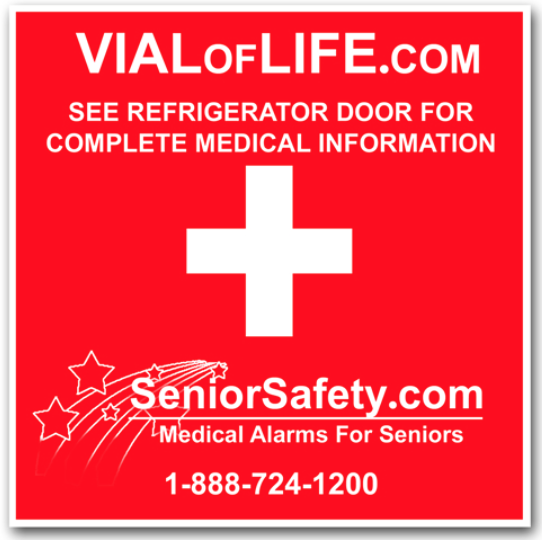
Create an online account. Provide your email address and create a password, and then give your name, mailing address, and phone number(s). You’ll be asked whether you want to participate in the First Responders Program, which gives medical personnel remote access to your information during an emergency.
NOTE: You don’t have to become a member, but if you do, you can update your information online as your prescriptions and medical situations change. If you choose not to become a member, any time you want to update your medical or personal information, you can print multiple copies of a blank form to fill in by hand, or return to the site to re-enter everything and print a typed copy. (View the site’s privacy policy here.)
Log in with the credentials you just created.
Create a new Vial of Life. Once you log in, you’ll be prompted to create a new vial. You’ll be asked for four types of basic information:
- Basic information
First, re-enter your full name and contact information. I’m not sure why this information can’t be directly imported from your account creation, but I suspect it’s to allow one person – a wife, for example – to create one family account and then create separate vials for herself, her spouse, and perhaps a grandparent or other person residing in the home, all without creating additional accounts.
You’ll also enter your gender, height, weight, hair color, blood type, and religion (much as you’d fill out in any hospital admittance form). There’s a section for adding whether you use a pacemaker or defibrillator (and a space for inputting the model number) or hearing aids, and for noting hearing impairment.
The next section asks about vision, whether you wear glasses and/or contact lenses, if you are blind in either eye or if either eye is artificial, and what your native language is. (Paper Doll would like to note that all of this information is useful, but it’s perhaps not entirely well organized. Harrumph.)
- Medical history
This section has two essay-style boxes. The first asks if you have any identifying marks, ostensibly to better identify who the patient actually is. The second asks, broadly, for all the conditions for which you’ve been treated in the past. (Again, Paper Doll isn’t in love with the organizational system here, and would prefer if the official program had a series of prompting checkboxes to ensure that users don’t forget any vital health events.)
- Current medical information
This section asks for your doctors’ contact information, the conditions for which you’re currently being treated and your current medications. The form does not ask for dosages, but I suggest you list both dosages and the frequency with which you take these meds. Where the form asks whether you have any medication allergies, if you are allergic to latex, I encourage you to list that, too.
The current medical information section has spaces for information regarding your last hospitalization and your medical insurance policy information. There are sections for noting whether you have a living will and whether you are an organ donor (and to whom medical professionals should speak regarding each issue).
- Emergency contact
The form has spaces for the name and contacting information for your emergency contact and what their relationship is to you.
I should note, another great unofficial program is listing your emergency contacts in your cell phone as ICE (in case of emergency). My phone, for example, lists “ICE Paper Mommy (and her contact info).”
Take a moment to add one or two of your emergency contacts to your cell phone directory. Just type ICE in the last name section and the person’s entire name (and perhaps their relationship to you) in the first name section. This way, if first responders check the I’s in your contact list, they’ll see ICE right away.
Once you fill out the form, you can save it (if you have created an account) and print the form. If you choose to save, the system will return you to a screen giving you the options to edit, print, or delete the vial you have saved.

THE NEXT STEPS
Put your Vial of Life together.
As I mentioned, some versions of the Vial of Life use an actual vial, but the Vial of Life Project recommends maintaining all of your information in a zip-lock bag. (If you get a kit from a community organization, you may be given a branded vinyl pouch.) Fold or roll the form (so it fits) and add any other pertinent information, including a DNR (Do Not Resuscitate) form, a recent photo of yourself, a recent EKG, your living will, and anything else you think might be pertinent.
Affix a Vial of Life decal to the baggie or vial.

Store your Vial of Life so it’s visible!
If you’re using a vial/bottle, place it in a very visible space on a high shelf. Don’t hide it among the eggs and soy sauce packets!
If you opt for the baggie, attach it to the front of the fridge. The Vial Of Life Project recommends doing so with tape, which probably won’t be aesthetically pleasing, so you might want to use a magnetized clip, such as those used for chip bags or for attaching papers to your filing cabinet. (The vinyl pouches tend to be magnetic.)

Attach the baggie or pouch near eye-level so it can be spotted quickly. (Your local first responders may have specific recommendations, such as to attach it to the top left side of the front of the fridge. Call your local firehouse to ask what they prefer.)
Affix a Vial of Life decal to your front door or in a highly visible front window (much like you’d affix a security company decal).
HISTORY OF VIAL OF LIFE and OTHER OPTIONS
The origin of the Vial of Life isn’t well-documented. We know that someone started putting vital information into medicine bottles and attached them to the interior of the fridge in a visible manner. Word spread over the years, and various community programs started offering advice on how to create a vial. Eventually, the Sacramento chapter of the American Red Cross handed off their resources to Vital-Link, Inc., one of the early “I’ve-fallen-and-I-can’t-get-up” medical alert companies.
For twenty years, the Vial of Life Project has operated as a 501(c)(3) non-profit and supplies free Vial of Life kits and decals/stickers to individuals and partner organizations, including senior citizen groups and community centers, pharmacies and hospitals, government agencies, towns and cities, Red Cross chapters, and various volunteer groups. (The American Senior Safety Agency, a medical alert company, covers the cost of the decals.)
The Vial of Life Project isn’t the only game in town. It’s founder specifically left the Vial of Life name in the public domain so that the program could be duplicated and used by other agencies and organizations. Although it’s the best-known, and costs nothing for individuals, there are a variety of alternative options, such as the File of Life.

StoreSmart, the same company that offers unofficial Yellow Dot stickers and envelopes, sells vinyl, magnetic-backed, closed-sided medical information pouches suitable for displaying at your home or office. They also sell window/door stickers and have free, downloadable medical information forms.

Whether you order the official Vial of Life, get a branded kit from your local hospital, pharmacy, or community group, purchase an alternative, or make your own, consider using the Vial of Life and encouraging your loved ones to do the same
Be healthy, be safe, and be organized.
Organize To Help First Responders: The Yellow Dot Program
Most of us spend time thinking about how to prevent medical emergencies. We try to exercise and eat healthily. We make doctor’s appointments, get all of the appropriate medical screening tests for our age group and gender, and we learn how to manage our health conditions in hopes of preventing complications.
Nobody likes to think about medical emergencies, but for the same reason we buy insurance (whether auto, home, health, or, in the worst case scenario, life insurance), we need to prepare for the unexpected. And when the unexpected does happen, we depend on first responders, particularly emergency medical technicians and paramedics, who have the training necessary to help us get safely treated.
So why not help the helpers?
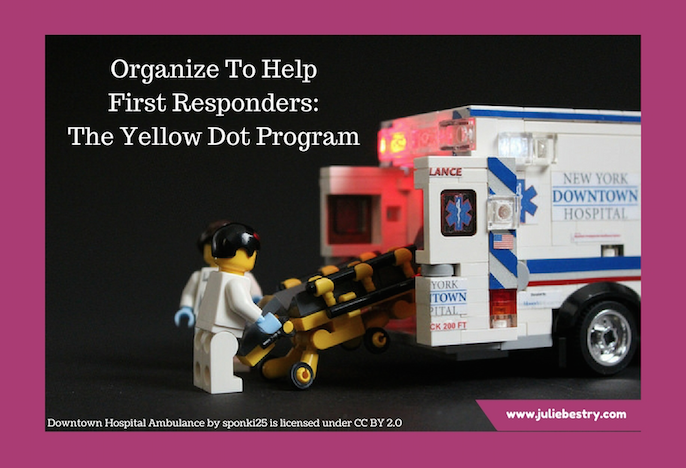
“Downtown Hospital Ambulance” by sponki25 is licensed under CC BY 2.0
In our next two posts, we’re going to look at two resources to organize essential medical information so that first responders can render aid when we need it, whether we’re out and about, or at home.
YELLOW DOT PROGRAM
At a DiabetesSisters meeting a few years ago, someone mentioned the existence of Tennessee’s Yellow Dot program, but almost nobody in the room was aware of this life-saving project.
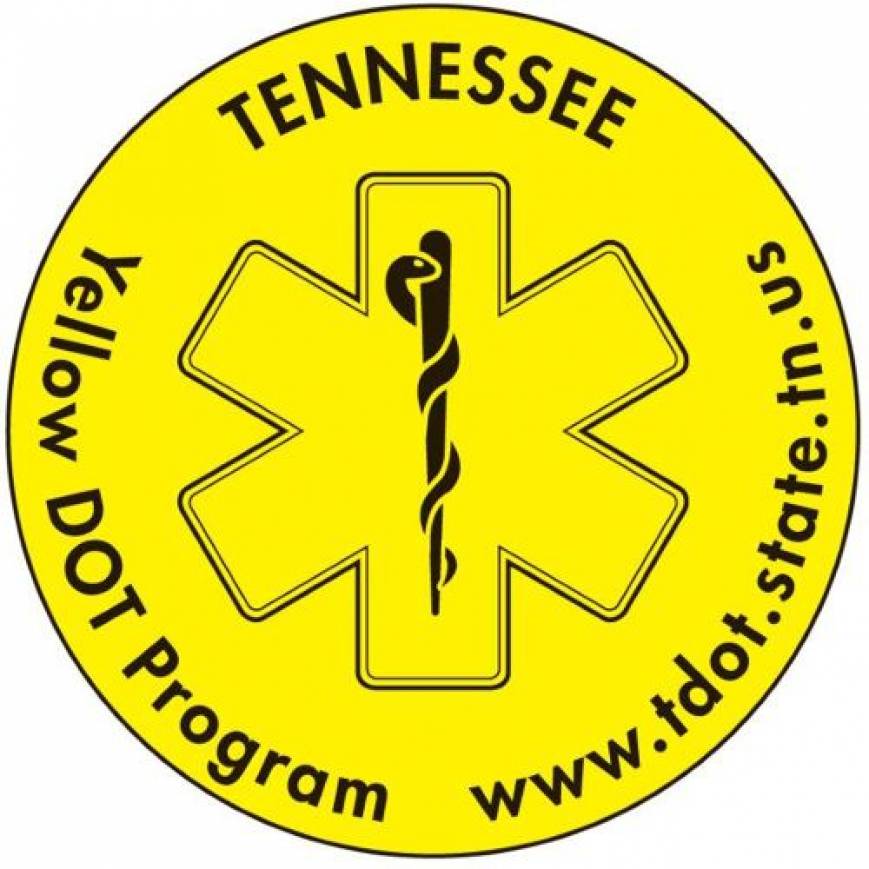
The Yellow Dot Program, available at no cost to participants, was initially developed as a regional program in the early 2000s. It is now a national program sponsored and funded by the United States Department of Transportation as a result of the work of the 113th Congress, the bill having been introduced by West Virginia’s Senator Joe Manchin III.
The purpose of the program is to help automobile drivers and their passengers communicate vital information to medical personnel (as well as police, firefighters, and other first responders) during road emergencies, like car accidents.
In case drivers or passengers are incapacitated, in shock, or are otherwise unable to communicate about their medical conditions, car owners can affix yellow stickers to their rear windshields to alert first responders that occupants of the car may require specialized medical attention. (Smaller stickers are available for motorcycle use.) Although state programs tend to accent Yellow Dot for use by senior citizens, anyone with a serious health condition or atypical health situation should consider making use of the program.
The stickers let first responders know to look in the glove compartment for a kit: a yellow plastic folder, container, or envelope. In it, they will find information regarding:
- the medical conditions, allergies, recent surgeries, and special needs of anyone riding in the car who might require special care
- lists of current prescriptions, dosages, and prescribers
- emergency contact information
- a photograph of the person so that he or she can be quickly identified as needing special attention
The Yellow Dot Program maintains no centralized database at any government or community level, so individuals concerned about privacy breaches should feel at ease. The information is maintained in the glove compartment and is not accessed by anyone (except the owner or passenger of a vehicle) unless there is an emergency situation.
At the meeting where I first learned about the Yellow Dot Program, we talked about the importance of police and medical personnel knowing that someone in the car might be suffering from hyper- or hypoglycemia, which can appear to the untrained eye to resemble drunkenness, stroke, dementia, or other health conditions.
Research shows that 90,000 to 100,000 individuals die each year due to adverse drug reactions, some of which result from standard treatments “in the field” to which an individual may be allergic. Similarly, an accident victim who has had a recent surgery may be at greater risk for complications, and first responders need to know that.
HOW TO PARTICIPATE
If you know someone who has a medical condition that might require special on-the-scene treatment by EMTs and paramedics, encourage them to sign up for the Yellow Dot Program. Management of the program varies by location, and though it’s overseen by state Departments of Transportation, management often occurs at the county level.
While some programs allow online sign-up, other communities require that participants come to an enrollment station or registration center (often at the nearest DMV, although some local businesses sponsor the printing of Yellow Dot stickers and kits and help enroll participants). Help your loved ones gather the vital paperwork – including medical and prescription information and a current photo – to put in the yellow folder to be kept in the glove compartment, and make sure you or they actually put the sticker on the rear windshield!
Although the Yellow Dot Program is funded nationwide, it is voluntary, and many states have declined to participate; other states have shown interest but have not yet rolled out their programs. If your state is listed (below) without a link, there is likely no centralized program in your state, and you will need to call or search for your county’s transportation department or division of aging services. (Yes, Paper Doll feels this is all very disorganized at the state and federal levels! Harrumph!)
Iowa
Kansas
Massachusetts (search “Yellow Dot Program” and the name of your town rather than county)
Minnesota
New Hampshire
North Carolina
Note: In 2017, Illinois mysteriously canceled participation in the Yellow Dot Program, but encourages all drivers to register with the state’s emergency contact database, which serves a similar function.
If yours isn’t one of participating states listed belong, contact your state’s Department of Transportation to inquire if and when the Yellow Dot program will be available for you. While you’re waiting, you can purchase an unofficial National Yellow Dot Program kit (with stickers and standard or folding pockets) directly from retailer StoreSMART in various batch sizes (from 2 to 2500) or in packages of five from Walmart.
In addition to the stickers and kits, StoreSMART has free, downloadable PDF medical forms. (You can also review the websites of the participating states, above, as many, such as Alabama, have their own downloadable medical forms, accessible to all.)
COMMUNITY OPPORTUNITIES
Various communities have found opportunities to use the yellow dots beyond private vehicles. Adult day care centers for senior citizens and people with disabilities, as well as traditional day care centers for children, can make use of the program by helping individuals in their care (and caregivers or parents) develop a person-specific packet, and make copies for family vehicles, program/center vehicles, and care centers.
Next time, we’ll be talking about the Vial of Life program, and how to ensure that first responders can locate your essential medical information when they attend to you at home. Until then, be healthy, be safe, and be organized.




Follow Me